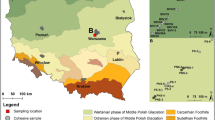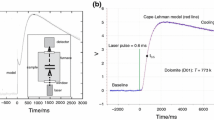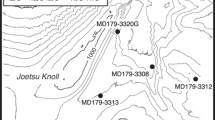Abstract
Thermal conductivity is an important physical parameter of rock, which requires indirect estimates. The existing rock thermal conductivity prediction model established from the perspective of particles has certain limitations, and the thermal conductivity calculation of sedimentary rock is not paid enough attention. In this paper, the thermal conductivity of 36 sedimentary samples is tested by the optical scanning method at a temperature of 300 K, and the calculated values from eight commonly used thermal conductivity prediction models with values obtained from laboratory tests are compared. A new mathematical model called the thermal conductivity entropy model (TCEM) is proposed to calculate the thermal conductivity of the rock from its mineral composition. The models for sandstone and mudstone by using thermal conductivity of the individual minerals are optimized, and the deviations between the measured and calculated values are compared. The results show that the values calculated by the eight models are all smaller than the test values, while the relative deviation of sandstone and mudstone are about 10% and 15%, respectively. TCEM provides a good coupling relationship (R2 = 0.54) for low-porosity sandstone. Due to the metamorphism of internal minerals, the thermal conductivity entropy is not linearly related to thermal conductivity. Therefore, the thermal conductivity entropy of minerals is used to predict the thermal conductivity of mudstone by multiple linear fitting (R2 = 0.62). TCEM eliminates the deviation caused by the spatial distribution of mineral particles in the rock in the traditional model.








Similar content being viewed by others
References
Abdulagatova, Z. Z., Abdulagatov, I. M., & Emirov, S. N. (2010). Effect of pressure, temperature, and oil saturation on the thermal conductivity of sandstone up to 250 MPa and 520 K. Journal of Petroleum Science and Engineering, 73(1), 141–155.
Abdulagatova, Z. Z., Kallaev, S. N., Omarov, Z. M., Bakmaev, A. G., Grigor’Ev, B. A., & Abdulagatov, I. M. (2020). Temperature effect on thermal-diffusivity and heat-capacity and derived values of thermal-conductivity of reservoir rock materials. Geomechanics and Geophysics for Geo-Energy and Geo-Resources, 6, 1–23.
Albert, K., Schulze, M., Franz, C., Koenigsdorff, R., & Zosseder, K. (2017). Thermal conductivity estimation model considering the effect of water saturation explaining the heterogeneity of rock thermal conductivity. Geothermics, 66, 1–12.
Andrés, C., Álvarez, R., & Ordóñez, A. (2016). Estimation of thermal conductivity of rocks from their mineralogical composition (Asturian Coal Basin, NW Spain) for modelling purposes. Environmental Earth Sciences, 75(3), 266.
Arafin, S. (2019). Thermophysical properties of reservoir rocks. Journal of Physics and Chemistry of Solids, 129, 99–110.
Chopra, N., Ray, L., Satyanarayanan, M., & Elangovan, R. (2018). Evaluate best-mixing model for estimating thermal conductivity for granitoids from mineralogy: A case study for the granitoids of the Bundelkhand craton, central India. Geothermics, 75, 1–14.
Chu, Z., Zhou, G., Wang, Y., Mo, P., & Tang, R. (2018). Thermal-physical properties of selected geomaterials: Coal, sandstone and concrete based on basic series and parallel models. Environmental Earth Sciences, 77(5), 1–9.
Clauser, C., & Huenges, E. (1995). Thermal conductivity of rocks and minerals. In T. J. Ahrens (Ed.), Rock physics and phase relations: A handbook of physical constants, AGU Reference Shelf (pp. 105–126). American Geophysical Union.
El Moumen, A., Kanit, T., Imad, A., & El Minor, H. (2015). Computational thermal conductivity in porous materials using homogenization techniques: Numerical and statistical approaches. Computational Materials Science, 97, 148–158.
El Sayed, A. M. A. (2011). Thermophysical study of sandstone reservoir rocks. Journal of Petroleum Science and Engineering, 76(3–4), 138–147.
El Sayed, A. M. A., & El Sayed, N. A. (2019). Thermal conductivity calculation from P-wave velocity and porosity assessment for sandstone reservoir rocks. Geothermics, 82, 91–96.
Fuchs, S., & Foerster, A. (2010). Rock thermal conductivity of Mesozoic geothermal aquifers in the Northeast German Basin. Chemie Der Erde-Geochemistry, 703, 13–22.
Fuchs, S., Foerster, H. J., Braune, K., & Foerster, A. (2018). Calculation of thermal conductivity of low-porous, isotropic plutonic rocks of the crust at ambient conditions from modal mineralogy and porosity: A viable alternative for direct measurement? Journal of Geophysical Research-Solid Earth, 123(10), 8602–8614.
Fuchs, S., Schütz, F., Förster, H., & Förster, A. (2013). Evaluation of common mixing models for calculating bulk thermal conductivity of sedimentary rocks: Correction charts and new conversion equations. Geothermics, 47, 40–52.
Gautam, P. K., Verma, A. K., Singh, T. N., Hu, W., & Singh, K. H. (2019). Experimental investigations on the thermal properties of Jalore granitic rocks for nuclear waste repository. Thermochimica Acta, 681, 178381.
Gong, L., Wang, Y., Cheng, X., Zhang, R., & Zhang, H. (2013). Thermal conductivity of highly porous mullite materials. International Journal of Heat and Mass Transfer, 67, 253–259.
Hartmann, A., Pechnig, R., & Clauser, C. (2008). Petrophysical analysis of regional-scale thermal properties for improved simulations of geothermal installations and basin-scale heat and fluid flow. International Journal of Earth Sciences, 97(2), 421–433.
Horai, K., & Simmons, G. (1969). Thermal conductivity of rock-forming minerals. Earth and Planetary Science Letters, 6(5), 359–368.
Javed, S., Khan, A., Dong, W., Raza, A., & Liu, S. (2019). Systems evaluation through new trey relational analysis approach: An application on thermal conductivity-petrophysical parameters’ relationships. Processes, 7(6), 348.
Jennings, S., Hasterok, D., & Payne, J. (2019). A new compositionally based thermal conductivity model for plutonic rocks. Geophysical Journal International, 219(2), 1377–1394.
Kämmlein, M., & Stollhofen, H. (2019). Lithology-specific influence of particle size distribution and mineralogical composition on thermal conductivity measurements of rock fragments. Geothermics, 80, 119–128.
Labus, M., & Labus, K. (2018). Thermal conductivity and diffusivity of fine-grained sedimentary rocks. Journal of Thermal Analysis and Calorimetry, 132(3), 1669–1676.
Lan, J., & Zeng, Y. (2013). Multi-threshold image segmentation using maximum fuzzy entropy based on a new 2D histogram. Optik, 124(18), 3756–3760.
Li, H., Wang, D., Singh, V. P., Wang, Y., Wu, J., Wu, J., et al. (2020). Developing a dual entropy-transinformation criterion for hydrometric network optimization based on information theory and copulas. Environmental Research, 180, 108813.
Luo, J., Qiao, Y., Xiang, W., & Rohn, J. (2020). Measurements and analysis of the thermal properties of a sedimentary succession in Yangtze plate in China. Renewable Energy, 147(SI2), 2708–2723.
Menard, M., Courboulay, V., & Dardignac, P. A. (2003). Possibilistic and probabilistic fuzzy clustering: Unification within the framework of the non-extensive thermostatistics. Pattern Recognition, 36(6), 1325–1342.
Mendes, M. A. A., Ray, S., & Trimis, D. (2013). A simple and efficient method for the evaluation of effective thermal conductivity of open-cell foam-like structures. International Journal of Heat and Mass Transfer, 66, 412–422.
Miao, S., & Zhou, Y. (2018). Temperature dependence of thermal diffusivity and conductivity for sandstone and carbonate rocks. Journal of Thermal Analysis and Calorimetry, 131(2), 1647–1652.
Nagaraju, P., & Roy, S. (2014). Effect of water saturation on rock thermal conductivity measurements. Tectonophysics, 626, 137–143.
Popov, Y., Tertychnyi, V., Romushkevich, R., Korobkov, D., & Pohl, J. (2003). Interrelations between thermal conductivity and other physical properties of rocks: Experimental data. Pure and Applied Geophysics, 160(5), 1137–1161.
Pribnow, D., & Umsonst, T. (1993). Estimation of thermal conductivity from the mineral composition: Influence of fabric and anisotropy. Geophysical Research Letters, 20, 2199–2202.
Sirdesai, N. N., Mahanta, B., Ranjith, P. G., & Singh, T. N. (2019). Effects of thermal treatment on physico-morphological properties of Indian fine-grained sandstone. Bulletin of Engineering Geology and the Environment, 78(2), 883–897.
Sun, Q., Zhang, W., Zhu, Y., & Huang, Z. (2019). Effect of high temperatures on the thermal properties of granite. Rock Mechanics and Rock Engineering, 52(8), 2691–2699.
Tamizdoust, M. M., & Ghasemi-Fare, O. (2020). A fully coupled thermo-poro-mechanical finite element analysis to predict the thermal pressurization and thermally induced pore fluid flow in soil media. Computers and Geotechnics, 117, 103250.
Tang, B., Zhu, C., Xu, M., Chen, T., & Hu, S. (2018). Thermal conductivity of sedimentary rocks in the Sichuan basin, Southwest China. Energy Exploration & Exploitation, 37(2), 691–720.
Wang, J., Carson, J. K., North, M. F., & Cleland, D. J. (2006). A new approach to modelling the effective thermal conductivity of heterogeneous materials. International Journal of Heat and Mass Transfer, 49(17–18), 3075–3083.
Wang, M., Xie, W., Huang, K., & Dai, X. (2019). Fine characterization of lithofacies and pore network structure of continental shale: Case study of the Shuinan Formation in the north Jiaolai Basin, China. Journal of Petroleum Science and Engineering, 175, 948–960.
Wang, W., Wang, D., Singh, V. P., Wang, Y., Wu, J., Wang, L., et al. (2018). Optimization of rainfall networks using information entropy and temporal variability analysis. Journal of Hydrology, 559, 136–155.
Woodside, W., & Messmer, J. (1961a). Thermal conductivity of porous media. I. Uncon-solidated sands. Journal of Applied Physics, 32, 1688–1699.
Woodside, W., & Messmer, J. (1961b). Thermal conductivity of porous media. II. Con-solidated rocks. Journal of Applied Physics, 32, 1699–1706.
Yang, X., Lu, T., & Kim, T. (2013). Thermal stretching in two-phase porous media: Physical basis for Maxwell model. Theoretical and Applied Mechanics Letters, 3(2), 21011.
Zarichnyak, Y. P., Ramazanova, A. E., & Emirov, S. N. (2018). Studying the temperature dependence of thermal conductivity in a rock of combined composition. Bulletin of the Russian Academy of Sciences: Physics, 82(7), 820–821.
Zhang, W., Sun, Q., Zhu, Y., & Guo, W. (2019). Experimental study on response characteristics of micro–macroscopic performance of red sandstone after high-temperature treatment. Journal of Thermal Analysis and Calorimetry, 136(5), 1935–1945.
Acknowledgements
This work was supported by the National Natural Science Foundation of China (41872170/41572140) and the National Major Science and Technology Projects of China (2016ZX05044).
Author information
Authors and Affiliations
Corresponding author
Ethics declarations
Conflict of interest
All authors certify that they have no affiliations with or involvement in any organization or entity with any financial interest or nonfinancial interest in the subject matter or materials discussed in this manuscript.
Additional information
Publisher's Note
Springer Nature remains neutral with regard to jurisdictional claims in published maps and institutional affiliations.
Appendix: Mineral Composition and Thermal Conductivity Values of the Samples
Appendix: Mineral Composition and Thermal Conductivity Values of the Samples
Sandstone | |||||||||
|---|---|---|---|---|---|---|---|---|---|
Sample | Thermal conductivity (W m−1 k−1) | Quartz (%) | Plagioclase (%) | Calcite (%) | Dolomite (%) | Siderite (%) | Rutile (%) | Clay (%) | Others (%) |
Q1929196 | 2.8951 | 11.41 | 38.29 | 4.40 | 0.00 | 0.00 | 0.00 | 20.80 | 25.11 |
Q1929197 | 4.3354 | 29.52 | 0.00 | 0.00 | 9.15 | 43.63 | 0.00 | 17.70 | 0.00 |
Q1929201 | 3.8126 | 14.16 | 8.60 | 0.00 | 16.21 | 4.37 | 5.43 | 51.22 | 0.00 |
Q1929202 | 3.3597 | 11.72 | 4.21 | 22.58 | 32.69 | 4.28 | 0.00 | 24.53 | 0.00 |
Q1929209 | 2.9738 | 7.36 | 35.26 | 0.00 | 8.79 | 4.22 | 0.00 | 44.36 | 0.00 |
Q1929211 | 3.9728 | 40.44 | 3.15 | 2.05 | 15.83 | 0.00 | 3.32 | 31.65 | 3.55 |
Q1929213 | 3.6175 | 14.72 | 0.00 | 0.00 | 0.00 | 40.22 | 1.53 | 43.54 | 0.00 |
Q1929215 | 3.1660 | 22.01 | 6.52 | 4.24 | 15.35 | 12.52 | 1.37 | 38.00 | 0.00 |
Q1929219 | 4.0005 | 20.69 | 10.21 | 9.97 | 0.00 | 24.61 | 1.43 | 33.08 | 0.00 |
Q1929220 | 3.1700 | 15.30 | 11.87 | 0.00 | 20.33 | 10.24 | 1.36 | 40.90 | 0.00 |
Q1929223 | 3.0058 | 15.49 | 0.00 | 0.00 | 0.00 | 32.70 | 1.49 | 50.32 | 0.00 |
Q1929225 | 2.5427 | 13.71 | 35.39 | 8.13 | 0.00 | 0.00 | 0.00 | 36.43 | 6.33 |
Q1929226 | 3.5723 | 11.62 | 29.20 | 25.46 | 0.00 | 0.00 | 0.00 | 27.37 | 6.34 |
Q1929228 | 2.6476 | 16.34 | 49.38 | 0.00 | 0.00 | 0.00 | 0.00 | 34.29 | 0.00 |
Q1929229 | 2.7087 | 15.37 | 28.17 | 3.17 | 0.00 | 0.00 | 0.00 | 37.92 | 15.37 |
Q1929230 | 4.1490 | 50.10 | 6.31 | 0.00 | 0.00 | 7.85 | 1.99 | 33.75 | 0.00 |
Q1929232 | 4.0400 | 36.14 | 9.44 | 6.15 | 12.85 | 3.56 | 3.31 | 28.55 | 0.00 |
Q1929233 | 2.9500 | 19.47 | 11.31 | 0.00 | 0.00 | 19.16 | 5.00 | 45.06 | 0.00 |
Mudstone | |||||||
|---|---|---|---|---|---|---|---|
Sample | Thermal conductivity (W m−1 k−1) | Quartz (%) | Plagioclase (%) | Siderite (%) | Rutile (%) | Clay (%) | Others (%) |
M1929198 | 1.4927 | 16.89 | 5.21 | 0.00 | 3.95 | 73.95 | 0.00 |
M1929199 | 3.9743 | 11.56 | 30.07 | 1.41 | 1.97 | 53.43 | 1.57 |
M1929200 | 3.9699 | 9.55 | 17.81 | 2.13 | 3.31 | 67.20 | 0.00 |
M1929203 | 3.0160 | 16.11 | 13.78 | 3.59 | 0.00 | 57.70 | 8.82 |
M1929204 | 4.0311 | 24.35 | 7.31 | 6.38 | 0.00 | 61.96 | 0.00 |
M1929205 | 2.5616 | 10.61 | 19.90 | 2.84 | 0.00 | 61.10 | 5.55 |
M1929206 | 2.1393 | 8.69 | 0.00 | 0.00 | 3.39 | 78.19 | 9.73 |
M1929207 | 3.2257 | 14.64 | 10.32 | 2.80 | 0.00 | 72.24 | 0.00 |
M1929208 | 3.0291 | 25.63 | 3.16 | 5.00 | 2.66 | 63.54 | 0.00 |
M1929210 | 3.3495 | 13.53 | 8.22 | 1.39 | 0.00 | 76.87 | 0.00 |
M1929212 | 2.4612 | 13.60 | 17.55 | 0.00 | 2.61 | 66.24 | 0.00 |
M1929216 | 4.1505 | 21.72 | 10.72 | 5.09 | 2.03 | 53.14 | 7.30 |
M1929217 | 2.5908 | 24.91 | 7.48 | 10.15 | 1.35 | 56.11 | 0.00 |
M1929221 | 3.0189 | 15.95 | 0.00 | 0.00 | 13.50 | 61.20 | 9.35 |
M1929222 | 2.6272 | 13.16 | 6.49 | 0.00 | 2.73 | 62.07 | 15.55 |
M1929224 | 3.0539 | 15.55 | 5.48 | 4.46 | 3.46 | 58.61 | 12.44 |
M1929227 | 3.9364 | 25.69 | 0.00 | 11.96 | 5.57 | 56.79 | 0.00 |
M1929231 | 3.2534 | 7.09 | 0.00 | 20.56 | 8.84 | 63.50 | 0.00 |
Rights and permissions
About this article
Cite this article
Jiang, X., Wu, C., Fang, X. et al. A New Thermal Conductivity Estimation Model for Sandstone and Mudstone Based on Their Mineral Composition. Pure Appl. Geophys. 178, 3971–3986 (2021). https://doi.org/10.1007/s00024-021-02824-w
Received:
Revised:
Accepted:
Published:
Issue Date:
DOI: https://doi.org/10.1007/s00024-021-02824-w




